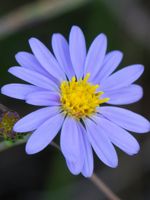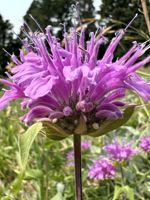Mon-Fri 9am - 5pm Mountain time
Smooth Aster vs Wild Bergamot
Symphyotrichum laeve
Monarda fistulosa
NOT AVAILABLE THIS SEASON - MIGHT RETURN
NOT AVAILABLE THIS SEASON - MIGHT RETURN
Smooth Aster is a native perennial wildflower known for its violet-blue, daisy-like flowers. They bloom later in the season, from late summer to early fall. The flowers attract a variety of pollinators, including bees, butterflies, and other beneficial insects. It also serves as a host plant for the Silvery Checkerspot (Chlosyne nycteis) and Pearl Crescent (Phyciodes tharos) butterflies, further enhancing its ecological value. This easy-to-grow wildflower is well suited for native wildflower gardens, pollinator gardens, and naturalization projects.
The Smooth Aster’s non-aggressive root system allows it to spread slowly, and it is more likely to reproduce by seed, which can be controlled through deadheading.
Wild Bergamot is a native perennial wildflower that is known for its fragrant lilac-purple tubular flowers. The flowers grow in dense terminal heads and bloom from mid-summer to early fall. Deadheading spent flowers will encourage new blooms, prolonging its display. They attract pollinators such as bees, butterflies, and hummingbirds. It also serves as a host plant for the Raspberry Pyrausta (Pyrausta signatalis) butterfly.
Wild Bergamot belongs to the mint family, and its leaves, stems, and flowers are all edible. The leaves can be used to make tea or as a flavorful herb, with a taste often described as a blend of oregano and thyme.
It is resistant to deer and rabbits but can be susceptible to powdery mildew if planted too densely with poor air circulation. Wild Bergamot tolerates heat, drought, and poor soils, making it a low-maintenance addition to a variety of projects. It is well suited for pollinator gardens, wildflower gardens and naturalization projects.

